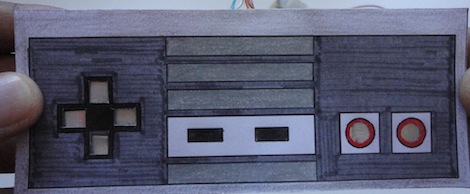
Hackaday has seen a ton of builds make use of the Arduino CapSense library of late, so it was only a matter of time before we posted a capacitive sensing game controller that is able to move sprites around a screen.
For this build, the controller is made out of small strips of Aluminum foil, wired straight to an Arduino with a few resistors. Once embedded inside a wonderful enclosure that brings about pangs of nostalgia it’s time tow write the game.
For the game portion of the build, Processing was brought into the mix to create a SpongeBob-themed ‘capture all the jellyfish in jellyfish fields’ game. By taping the contacts for the d-pad, the player can move SpongeBob around to catch jellyfish. If you’d like to give the game a go, you can play it in your browser on the project page.
This isn’t the first – or the last – CapSense build we’ll see on Hackaday, but it is the first one dedicated to making a DIY (albeit Nintendo inspired) video game controller. If six buttons aren’t enough, you’ll just have to wait for the PS3 version.
















I had this long tirade in my head about how people keep trying to shoehorn touch technologies into “older” technologies such as making NES controllers or creating “buttons” on touchscreens (Check out the Shining Force by SEGA for Android or any number of like games to see what I mean) but after reading over the link, it actually isn’t half bad.
It’s more about understanding and leveraging touch capacitance than using an Arduino or shoehorning one tech into another.
As long as the next related article isn’t a Genesis/SNES controller, it’ll be an improvement in the right direction. I’ve already got a couple of ideas that might be fun.
Thanks for featuring my project Hackaday!
SavannahLion,
I fully understand what you mean, and appreciate that you read my post and had a slight change of heart. Actually, I was born well after NES became old school!
It just seemed like a simple little way to give my project a theme. As you noted, my main purpose was to understand and implement capacitive touch sensing technology, not just jury-rig some random things together and call it something new. Plus, I wanted to learn how to use Processing, but found tutorials to be too dry. This was a good way to force myself to learn how to use it.
I too have other ideas to further use touch capacitance in more novel ways, and hope you find my future projects more significant. Thanks!
Can’t argue with that, neat project, simple to understand…. Good job.
BTW, neat game, my 3 yr old boy would love it…
Ever heard of the Turbo Touch 360?
http://en.wikipedia.org/wiki/Turbo_Touch_360
Wonder why it was rated one of the worst controller ever? Well, gamers like to rest their fingers on the buttons while not pressing them (I know I do). There is a reason while controllers stick to using antiquated buttons in the 21st century.
This would be interesting to integrate into a portable console hack like those Ben Heckendorn builds.